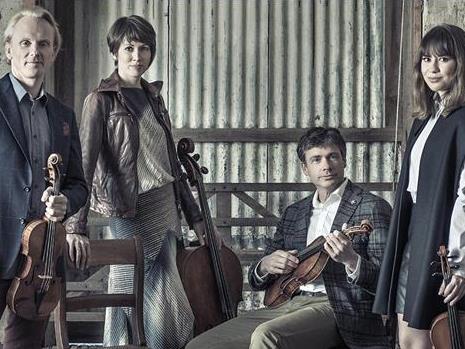The Australian String Quartet. Photograph via Melbourne Recital Centre.
The Australian String Quartet has regrettably experienced several changes to its line-up in recent years, the latest replacing the group’s first and second violinists. This occasion was my introduction to the ASQ in its latest and one hopes more enduring manifestation. From the outset I was impressed by an ensemble in total accord with a maturely eloquent ‘voice’, honed through its enviable use of a matched set of 18th-century Guadagnini instruments and showing confidence manifest in both sonority and stage presence. Apart from the cellist playing on a raised platform, the musicians stood throughout, creating an attractive open and expressive sound. Three quite dissimilar works were featured on the program: Mozart’s Quartet in F major K590, György Ligeti’s first work in the form, composed in 1953-54 titled Métamorphoses Nocturnes and Ravel’s sole String Quartet in F major. It was pleasing to hear the ensemble approach each composition as a separate work of Art, with changing sensibilities and contexts ranging from Viennese Classicism to sinewy Gallic Impressionism with grim Soviet angst in between.
Mozart’s F major Quartet, K590 is one of a set of six dedicated to King Friedrich Wilhelm II of Prussia, an amateur cellist. It was written a year before the composer’s death and at a time when Mozart was experiencing flagging popularity in Vienna and significant ill-health. The work was performed with an empathy and sensitivity for Classical style, demonstrating refinement in phrasing and accurate intonation. The gracious opening Allegro moderato was perfectly paced with material fluently passed between instruments as in an effortless conversation between friends. Similarly, the tempo of the Andante was perfectly judged affording a wonderful buoyancy. A touching tribute to Mozart’s friend Joseph Haydn, the movement presents a set of embellished variation cells that Alfred Einstein described as seeming to “mingle the bliss and sorrow of a farewell to life”. The Menuetto: Allegretto had visceral drive and energy contrasted with the delicate lilt of its central section. The exuberant Allegro took off at a pace that very nearly led to derailment at the onset but soon settled into the ebullient, characterful and intricately delineated exposition from all four instruments that determines a first-rate performance such as this.
The highlight of the program for me was György Ligeti’s skilfully crafted first Quartet, written on the cusp of his departure from Soviet Hungary for Vienna. With characteristic succinctness musicologist Richard Toop writes that “Ligeti gained the reputation as a perfectionist, a master jeweller, constantly whittling away at his chosen diamonds”. The work is crammed with the intricate sounds of night, some so fragile so as to be almost inaudible. His refinement of sonority and texture is manifest in a raft of extended techniques employed throughout the work, whereby we can hear the genesis of the composer’s later writing including his most famous work Atmosphères for orchestra written seven years later, music used for Stanley Kubrick’s film 2001: A Space Odyssey. The Australian String Quartet gave a refined, totally engaged and virtuosic performance; my hope is that the ensemble will one day include the composer’s equally fine second String Quartet (1968) in its repertoire.
Lastly, the ASQ gave a fine performance of Ravel’s String Quartet that was true to its painterly Impressionistic inspiration where texture and colour are emphasised over clarity of subject matter and form, while savouring ‘the moment’ in sound rather than there being any requirement of lengthy development. Debussy described this music as aiming to sound “like a sketch…an improvisation”. Certainly the ASO immediately found the elegant and genial core of the opening movement (Allegro moderato – trés doux) which conjured wind-blown poplars and dappled sunlight. The Basque Assez viv – trés rhythmé delighted for its dignity and vigour. The remaining two movements were faultless and contributed to this beautifully shaped and polished performance.
In 2017 the Australian String Quartet will again present a national subscription series as well as festivals in Dunkeld, Victoria and Margaret River, Western Australia. Performances of this quality are rare and deserve to be sold out.
Rating: Four stars out of five
Metamorphoses
Australian String Quartet
Dale Barltrop and Francesca Hiew, violins
Stephen King, viola
Sharon Draper, cello
Elisabeth Murdoch Hall, Melbourne Recital Centre
Monday, 24 October, 2016





